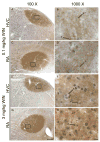CB(1) cannabinoid receptor activation dose dependently modulates neuronal activity within caudal but not rostral song control regions of adult zebra finch telencephalon
- PMID: 18509622
- PMCID: PMC2586593
- DOI: 10.1007/s00213-008-1190-z
CB(1) cannabinoid receptor activation dose dependently modulates neuronal activity within caudal but not rostral song control regions of adult zebra finch telencephalon
Abstract
Rationale: CB(1) cannabinoid receptors are distinctly expressed at high density within several regions of zebra finch telencephalon, including those known to be involved in song learning (lMAN and Area X) and production (HVC and RA) because (1) exposure to cannabinoid agonists during developmental periods of auditory and sensory-motor song learning alters song patterns produced later in adulthood and (2) densities of song region expression of CB(1) waxes and wanes during song learning. It is becoming clear that CB(1)-receptor-mediated signaling is important to normal processes of vocal development.
Materials and methods: To better understand the mechanisms involved in cannabinoid modulation of vocal behavior, we have investigated the dose-response relationship between systemic cannabinoid exposure and changes in neuronal activity (as indicated by expression of the transcription factor, c-Fos) within telencephalic brain regions, with established involvement in song learning and/or control.
Results: In adults, we have found that low doses (0.1 mg/kg) of the cannabinoid agonist WIN-55212-2 decrease neuronal activity (as indicated by densities of c-fos-expressing nuclei) within vocal motor regions of caudal telencephalon (HVC and RA) while higher doses (3 mg/kg) stimulate activity. Both effects were reversed by pretreatment with the CB(1)-selective antagonist rimonabant. Interestingly, no effects of cannabinoid treatment were observed within the rostral song regions lMAN and Area X, despite distinct and dense CB(1) receptor expression within these areas.
Conclusions: Overall, our results demonstrate that, depending on dosage, CB(1) agonism can both inhibit and stimulate neuronal activity within brain regions controlling adult vocal motor output, implicating involvement of multiple CB(1)-sensitive neuronal circuits.
Figures






References
-
- Reiner A. Organization and evolution of the avian forebrain. The Anatomical Record Part A: Discoveries in Molecular, Cellular, and Evolutionary Biology. 2005;287A:1080–1102. - PubMed
-
- Bolhuis JJ, Hetebrij E, Den Boer-Visser AM, De Groot JH, Zijlstra GGO. Localized immediate early gene expression related to the strength of song learning in socially reared zebra finches. European Journal of Neuroscience. 2001;13:2165–2170. - PubMed
-
- Bottjer SW, Johnson F. Circuits, hormones, and learning: vocal behavior in songbirds. J Neurobiol. 1997;33:602–618. - PubMed
-
- Bottjer SW, Miesner EA, Arnold AP. Forebrain lesions disrupt development but not maintenance of song in passerine birds. Science. 1984;224:901–903. - PubMed
-
- Chaperon F, Thiebot MH. Behavioral effects of cannabinoid agents in animals. Critical Reviews In Neurobiology. 1999;13:243–281. - PubMed
MeSH terms
Substances
Grants and funding
LinkOut - more resources
Full Text Sources
Miscellaneous

